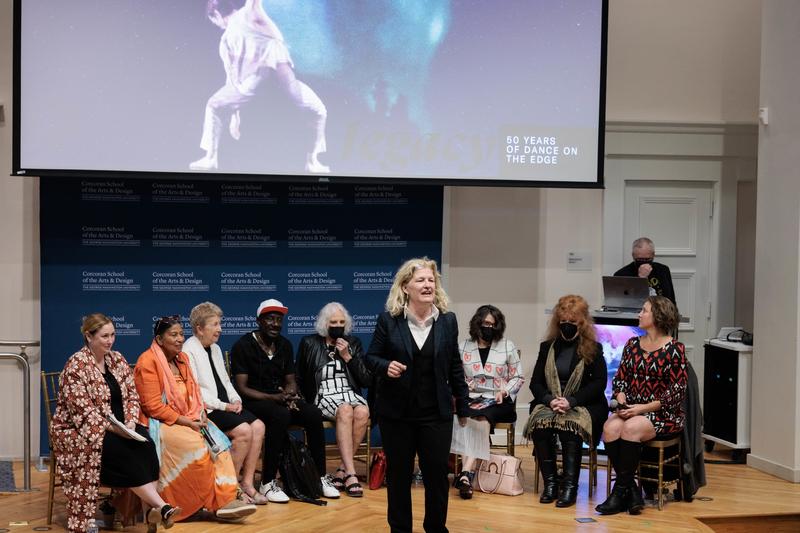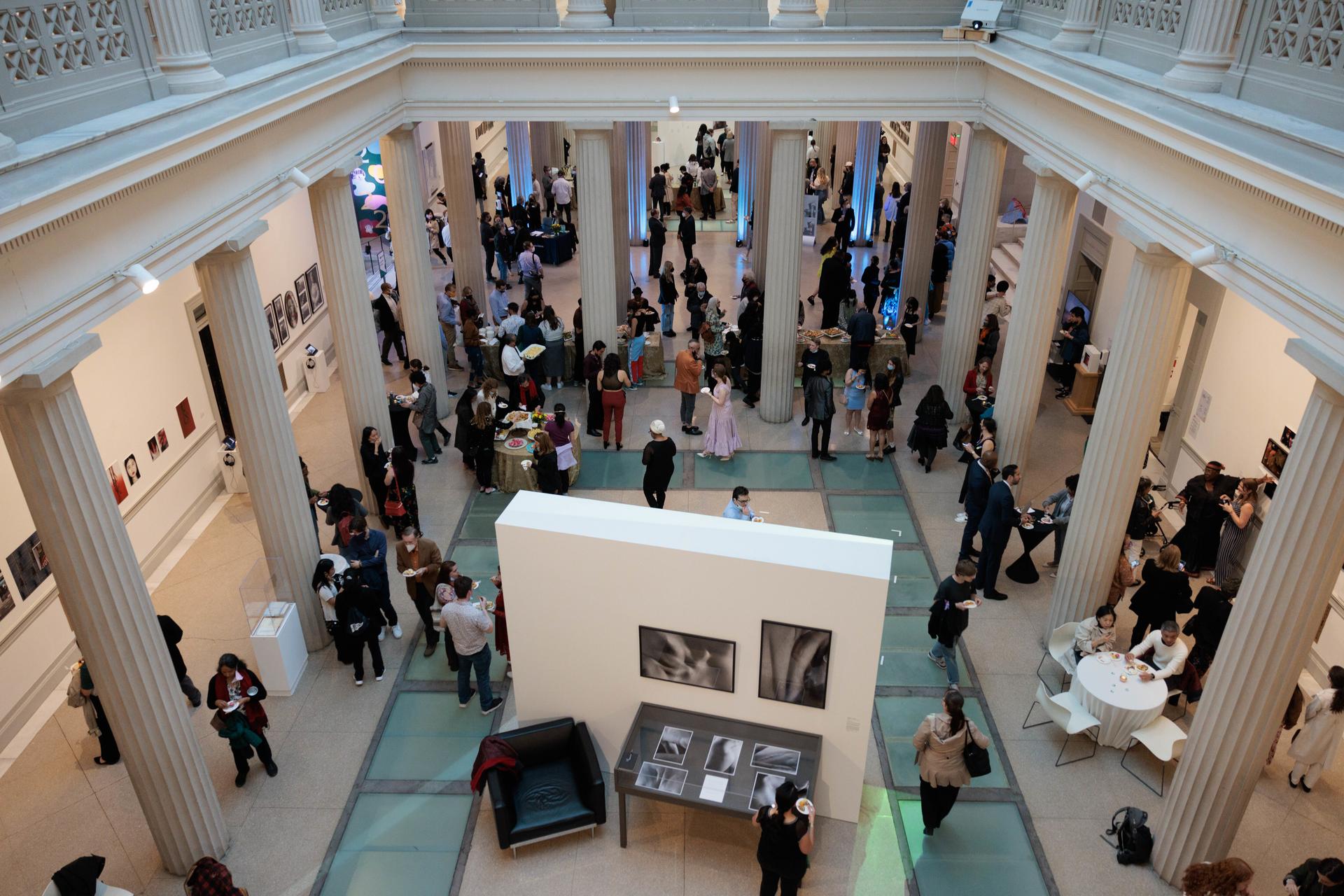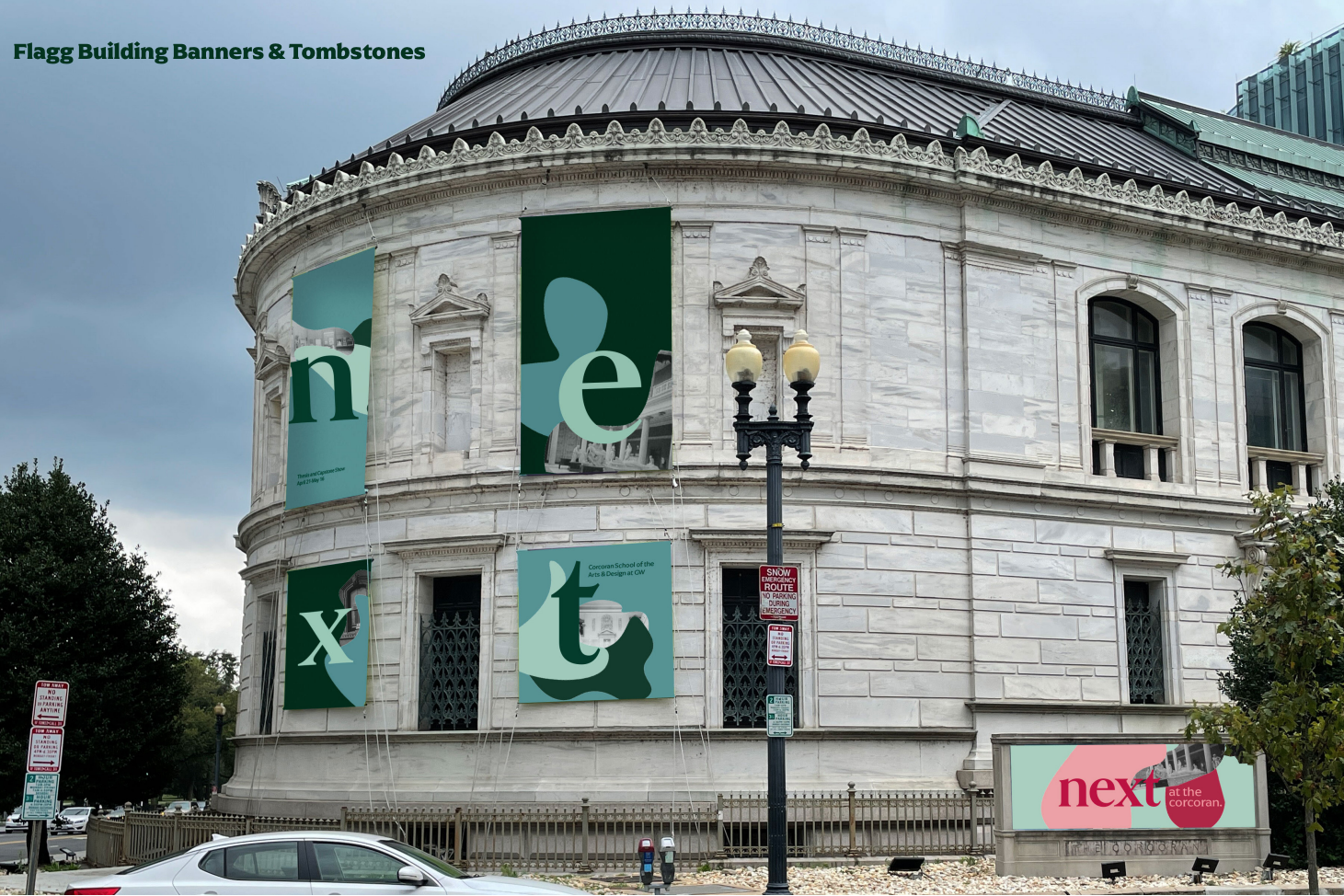A Washington, D.C., arts hub on the GW campus will raise its profile higher this year when the Columbian College of Arts and Sciences’ Corcoran School of the Arts and Design presents a newly expanded version of its annual NEXT exhibition, now presented as a festival encompassing Corcoran student performances, art exhibitions and symposia at locations across campus.
The festival will stretch over 30 days from April 20 to May 20, with a gala extravaganza on May 4 from 6:30–9 p.m. in the Flagg Building Atrium. Light refreshments will be served. Attendance is free. The festival will serve simultaneously as a showcase for the work of Corcoran students and a celebration of the arts. A schedule of festival events and link to RSVP are online
Approximately 100 students will present the work they have been doing as part of their senior capstone or master’s thesis projects. For the first time in the history of NEXT, students from all Corcoran programs will be included.
“The Corcoran School of the Arts and Design includes programs in studio fine arts, graphic design, interaction design, photography, photojournalism, interior architecture, art history and the performing arts: music, theater and dance,” said Lauren Onkey, director of the Corocoran School. “Our goal this year is that by putting this all under one umbrella, we can let people see the range of work the Corcoran School of the Arts and Design is doing and what our students are accomplishing. Some of our audience may be thinking only in terms of visual arts or only in terms of dance, and we really want to create multiple opportunities for the community to experience the arts.”
There are several new features in this year’s festival, according to Babette Pendleton, exhibition and programming associate for the Corcoran. Music and dance students are utilizing the Betts Theatre, Lisner Auditorium and the University Student Center. There will be informal presentations in Phillips Hall and in newly revamped dance spaces at the Blackbox Theatre and Building J, and some students will be creating outdoors. Events could trail further into Foggy Bottom, as some visual artists are creating small activations around campus.
Also new this year, the Corcoran is partnering with the Honey W. Nashman Center for Civic Engagement and Public Service, which gives out awards to students whose projects demonstrate strong civil engagement, to heighten the focus on those awards. Finalists will present their work in front of judges and other students, who will vote, and awards will be given.
Another new feature will be revamped symposia. For a day focused on research of museum studies students and art history students, Aruna D’Souza, currently the William Wilson Corcoran Visiting Professor of Community Engagement, will appear. Students will interact with her and she will take questions from the audience. A student group, VASC (for Visiting Artists and Scholars Committee) is helping to curate that day.
“There are some surprises in store this year for sure,” Pendleton said. “We are showcasing design thesis projects from the interaction design and interior architecture programs inside the School of Engineering and Applied Science’s annual Student Research & Development Showcase. This is an exciting opportunity for cross-pollination between design and engineering which we hope will lead to more collaboration in the future. We are bringing back the annual Dudley Memorial Lecture, which this year will feature special guest Valerie Cassel Oliver, curator of modern and contemporary art at the Virginia Museum of Fine Arts. And we are opening the historic Salon Doré for music senior capstone performances. Another new thing is that the festival as a whole will be featured on a digital program, so people will have mobile access to events and to regular updates.”
A showcase for diversity and interdisciplinary voices
“I want to emphasize that all of our programs are represented in this end-of-year festival,” Onkey said. “Students can come here to work on one discipline, but can also draw from a range of programs at the Corcoran.”
To give one example of this kind of interdisciplinary fertilization, an interaction design student will utilize training that she got working with the costume shop along with lessons she learned about sound from the music department. Her project, showing the fashion women once had to wear in the workplace—petticoats and heels—is about the history of clothing that women had to wear while doing dirty, grimy work. Costumed theater students will do a live performance and a video will describe the arc of this history.
“It’s not like the audiences for visual art don’t care about theater or dance,” Onkey said. “Audiences are moving across the arts, and our students are creating across disciplines, so we’re excited to showcase that in multiple locations across the campus, as well as in the Flagg Building.”
Both Onkey and Pendleton say that this year’s NEXT will have a special excitement factor due to the fact that it brings the first full year since COVID lockdown to its climax. The experience of artists working with each other in person to present their work before a live audience is unique and irreplaceable.
“This is a moment of revitalization,” Onkey said. “Our students were producing work at home, including theater and dance, but that alchemy of creators together feels very powerful.”
GW Today asked a group of students to describe the work they will be presenting at the festival.
Soffia Obando Carcamo
(B.F.A., Studio Arts)
I’ve been exploring the sculptural qualities of biopolymers, specifically clay biopolymers. I’ve been running tests to understand how some ingredients make it pliable or rigid, how thickness can give structure, and how different clay percentages add different textures. Though it is a methodical process, my research is not entirely scientific. I also try to find a common ground where the material and I have equal control over the final piece. For NEXT, I’ll show my material explorations of clay biocomposites with a large sculpture as the culmination of my research. I’m also interested in clay as an agent of decomposition of organic materials and death as a catalyst for growth. These ideas turned into sculptures of raw clay with mold-growing flowers to encourage people to acknowledge the full circle of life, not just the blooming stages that are pleasing to the eye.
Christina Villadolid
(M.F.A., Social Practice)
My installation, “In the Presence of Savage Women,” is site-specific to the marble staircase ascending to the South Bridge of the Flagg Building, which had been the entry point to an exhibition I made in December, “Filipinabilia: Origins, Rituals, Artifacts.”
During the Philippine-American War, American pro-expansionist politicians bred harmful narratives of Filipinos as “savage” to legitimize violent white supremacist manifest destiny in the Philippines. In response, I create space for counter-narratives to the histories we’re taught and question who gets to author the story. I reclaim the word, “savage” to mean fierce, fearless, unbounded liberty. My use of materials such as banana leaves, twine and rice is a nod to my ancestors’ connection to the land and resourcefulness while challenging regimes of value.
This installation acts as a marker of resilience to generational trauma caused by American policy, inviting collective healing in this public space.
Dajana Peric
(M.F.A., Studio Arts)
For the NEXT festival, I will do a performance piece called “Border Impasse” dealing with personal investigations of shared cultural identity. The work focuses on the burden on the individual through changes in the course of history—the shifting of borders and the consequences they leave behind. Integrating movement and voice, I will sing iconic Serbian folk songs that emphasize the value of cultural heritage, but also touch on parts of our painful history that concern territorial loss, the struggle for survival and the loss of human life. I will symbolically draw red lines on the wall in the Rotunda circle as a metaphor for the marking of maps and borders, presenting the hopelessness of the situation confronting many people.
Nica Albertson
(B.F.A., Music)
My capstone will be a musical performance where I use guitar, voice, bass, keys and electronics to bring my compositions to life. Last year I released a record titled “Tender Hearted,” and anyone who has heard it knows I love harmonies. The component of my live solo performances that's always felt missing is a certain warmth and “width” that really only comes from diverse instrumentation and layers of harmony. It's hard to do that alone on a stage. Thanks to software and various musical tools, I can bring this vision to life in my capstone. This event will be particularly exciting to attend because of the lighting design! Shoutout to Professor Andrew Toy, an amazing drummer and music technologist. Thanks to him, I have learned to use lighting to amplify phrasing and add some visual stimulation (but not too much). Join us on Saturday, May 6, at 7:30 p.m. in the Corcoran Flagg Building Atrium!
Anne Laurie Joseph
(B.A., English and Music)
I’m a graduating senior double majoring in English literature and music. I’ve written a musical, “No Safe Place,” exploring the reality of gender violence by taking a very personal look at family, generational trauma and the failed systems of power that perpetuate gender and domestic violence, as well as homophobia. Following the story of Adira, a young woman in her 20s, as well as the stories of a number of women of different backgrounds, the show shines light on the painful trek of healing and coping through gender violence, while also displaying the joy that exists in finding support and a community.
Will Allen-DuPraw
(M.A., New Media Photojournalism)
My capstone project, “Arming the Left,” is on the surface about the Socialist Rifle Association—basically a gun club for leftists. But beneath the surface, it's really about a group of people who don't feel safe in this country and can't count on the police or the powers that be to protect them. There’s this perception that gun culture is entirely conservative, white and masculine, and that's not necessarily incorrect—but groups like the SRA are changing the scene, and that's what I'm documenting in my project. Many of the members of the group are queer, or trans, or BIPOC—demographics that have been increasingly targeted by far-right extremist violence, and in some cases violence from the police themselves. The SRA has created a safe space for people of any and all backgrounds to learn about guns safely, and away from the traditional American gun culture, which heavily overlaps with the types of people that have committed violence against their communities. They basically said, “Enough is enough, and if the state won't protect me and my people, then I'll do it myself.” They're a really interesting group of individuals that I think most people would not have thought to be involved with firearms.
Amanda Bohn
(B.F.A., Graphic Design)
My thesis explores memories as both collectively understood and deeply personal. Graphic designers are visual communicators, and recently I’ve found myself more interested in ways that design is intrinsically human, rather than its involvement in consumerism. For the festival, I’ve designed visualizations of five different memories that we all experience often and can all understand. The memories themselves, though a little mundane, are what I would consider very familiar, so my hope is that they resonate with the audience. The five memories are: “Waking Up,” “Laughter,” “Crying,” “Feeling Full after Eating” and “Happy Birthday.” The visualized memories will be displayed on the atrium walls, along with my book, which will include all parts of the process leading up to the exhibition. After a year of accumulated research, I’m excited to show my work at Next 2023 and cannot wait to celebrate with my classmates at the festival!
Jenna Banks
(B.F.A., Photojournalism)
My work for NEXT is a photographic series titled “Room to Breathe,” focusing on my relationship with Rock Creek Park. I printed five large-format images that foreground the connection between nature and the body. Green spaces are very healing for me, and “Room to Breathe” highlights the caring tendencies of the park as well as self-care. All of this rounds out as this collaboration with the landscape is created out of love and caring for Rock Creek. These images are printed on bamboo paper, which is really lovely and opens up all the natural, lush textures. I’m looking forward to seeing the work live and breathe on its own alongside what everyone else has been working on.
Becca Friedman
(M.F.A., Interior Architecture)
For my capstone project, I’m designing an art therapy clinic and inclusive art center for elementary school-aged children with emotional and developmental needs. Designed to blur the lines between therapy and fun, Art to Heart fosters joy and community for patients, parents and staff. From creating a blanket fort to discovering a new hiding place, children seek out spaces that offer both protection and unique vantage points. These places provide security while also creating a feeling of freedom. Driven by architectural gestures supporting this concept of “enveloped freedom,” Art to Heart incorporates principles of enclosure and contrast to meet the neurodiverse needs of its users. The first level, complete with group art studios, a clay bar and sensory-driven art playground, serves as an oasis for creativity and exploration. In contrast, the second floor offers individual therapy rooms and private enclaves to safely encourage emotional expression.













